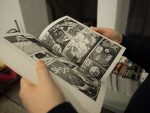Creator and director of Neon Genesis Evangelion, Hideaki Anno, released a statement prior to the 2007 debut of “Evangelion: 1.0 You Are (Not) Alone,” stating: “Eva is a story that repeats…it is a story of will; a story of moving forward, if only just a little.” When watching the series from start to finish, plus the four movie-length additions to the show’s narrative, I noticed each movie is an exact replica of the same major events. A cataclysmic event called the “Third Impact” takes place after the main character Shinji Ikari has the wish to find closeness with others. This leads to the actual disintegration of the physical self into the primordial soup the people in the Evangelion universe emerged from. The cycle repeats, however, with each one, and Shinji learns to recognize their faults, how to fix it, and is given the chance to “re-do” his actions until he finally learns his lesson.
Neon Genesis Evangelion (Animated Series)
“Neon Genesis Evangelion” made its debut in 1995, four years after the 1991 collapse of Japan’s economy. In the 10 years following, the production of new anime series stagnated. Amid a sea of ideas that failed to make the cut, Anno, with a few of his own failed projects in his pocket, helped revive anime from its late 20th-century lull.
Just as Shinji is rushed to Tokyo-3 and forced to pilot Eva-Unit 01 with little explanation, the viewer is pushed into the thick of the plot and knows just as much as Shinji does. The feeling of being lost pervades the series and the viewer is made to put themselves in the shoes of Shinji, someone who wouldn’t run away from the fact that he was the sole person able to save the world from the human instrumentality project: forced immortality through the combination of all human souls into one being.
In the last two episodes of the series, Shinji is faced with all of the decisions he’s made as he grapples with justifying the reason for his existence and whether or not he deserves to exist after all he’s done. Ultimately, Shinji believes he deserves to live because he pilots Eva Unit-01, the source of his self-worth, and protects all of humanity — that is, he does whatever others want him to do.
Everyone believes in the importance of Eva Unit-01; it protects all of Tokyo-3 from attack and at the end of each battle, everyone sings Shinji’s praises. However, Shinji believes that without the Eva, he has no worth.
“Neon Genesis Evangelion” ends with Shinji finally understanding that it isn’t the Eva or the approval of others that will make him happy; instead it is self-validation irrespective of the opinions of others that leads to true happiness.
Neon Genesis Evangelion Rebuilds
The four “Neon Genesis Evangelion” rebuilds — “Evangelion: 1.0 You Are (Not) Alone,” “Evangelion: 2.0 You Can (Not) Advance,” “Evangelion: 3.0 You Can (Not) Redo” and “Evangelion: 3.0+1.0 Thrice Upon a Time” — are alternate universe films within the franchise that answer the question: “What if the Third Impact never occurred and Shinji never resolved his trauma?”
Just as the original “Evangelion” series cycled through and explored the struggles of each of the main characters, the four-part rebuild series does the same, examining the consequences of Shinji failing to resolve his trauma.
1. “Evangelion: 1.0 You Are (Not) Alone” & “Evangelion: 2.0 You Can (Not) Advance”
The first two films in the rebuild series are connected to each other — “Evangelion 1.0” is a retelling of episodes 1-6 and “Evangelion 2.0” is a continuation of the first movie, however, ending with the Third Impact being stopped by Shinji’s new counterpart, Kaworu Nagisa.
The start of Shinji’s trauma cycle begins here and without that moment of introspection granted to him in the original series, the world once again faces the Third Impact, not as a result of a genuine attempt to resolve the woes of humanity, but to grant Shinji’s selfish wish. This time around, Shinji finds validation not in himself, but from his fellow pilot Rei Ayanami, and he uses his new ascended being status to try to save her instead of repairing the state of the world; he exclaims: “I don’t care what happens to me. I don’t even care what happens to the world, but I’m bringing Rei back.”
The movie ends with the start of the Third Impact again, but not before Kaworu can stop it, afterward telling Shinji, “This time, I will show you happiness.” In the original series and in the rebuilds, Kaworu is known as the 13th angel that needs to be destroyed in order to bring about the Third Impact and ironically, is working for the organization SEELE, whose purpose is to trigger the Third Impact. Kaworu’s plan to “show” Shinji happiness stems from SEELE’s goal of uniting humanity into one to achieve true peace. In Kaworu’s mind, Shinji is equal to humanity, and if SEELE says ascending above the human existence will bring happiness, then letting Shinji form that being is the way to do it.
2. Evangelion: 3.0 You Can (Not) Redo
The title of “Evangelion 3.0” mirrors the film’s ending and the arrival of the Fourth Impact. From the start of the film, Kaworu figures that if Shinji can undo the destruction he’s caused as a result of the failed Third Impact, it might make him happy. However, once it comes time to set off the Fourth Impact and wish for a restored world, Kaworu realizes too late that his original plan of letting Shinji start the Fourth Impact will only lead to the total destruction of humanity, which he came to love — its individuality and the human condition, (something Kaworu as an angel cannot understand) and, by extension, Shinji.
In the end, he decides to sacrifice himself as the 13th angel in order to prevent Shinji from kicking off the Fourth Impact. Through this, Kaworu finally learns that it isn’t the combination of everyone’s souls that will make Shinji happy, but rather, the lesson in self-validation that Shinji needs to learn to break the first part of the cycle.
3. Evangelion: 3.0 + 1.0 Thrice Upon a Time
By the start of “Thrice Upon a Time,” Shinji is absolutely catatonic after almost destroying the world for a second time. Throughout the first part of the film, Shinji spends his time recovering from Kaworu’s death in a town built on top of the destroyed Tokyo-3. Rei Ayanami substitutes for Kaworu until his return later in the film, serving as the person who pulls Shinji out of his depressive state and awakens him from his cycle of self-loathing. After Rei dies in front of him just like Kaworu, Shinji begins the process of doing his part to end the cycle of pain and is finally able to confront his father, Gendo Ikari, the original catalyst of the cycle.
The whole time, from the 1995 series until the last film, reuniting with his wife through human instrumentality was always Gendo’s goal, one that he neglected Shinji for so long in order to reach. During their confrontation, Gendo explains why he went as far as he did with instrumentality: He wanted to be reunited with the only person who truly understood him — his late wife, Yui Ikari. In the end, he learned that instrumentality would never bring Yui back, but by seeing her likeness in Shinji, Gendo found her legacy.
After helping everyone else, Shinji reset his own world— just like everyone else’s — one without Evangelions. The explosive DSS choker he wore in the rebuilds that prevented him from piloting his Eva is removed, freeing him from the world of “Evangelion” forever.
The Neon Genesis Evangelion series and rebuilds are critiques of the normalization of escapism and the refusal to move on in terms of shows with “disappointing endings” in otaku culture. As a series that was never meant to continue past the show’s end, hopefully that message finally sunk in the fourth time around.

















